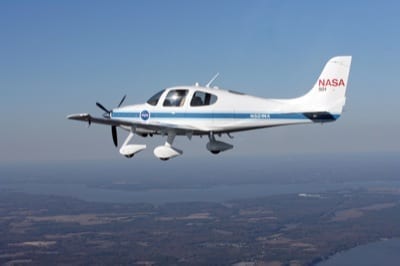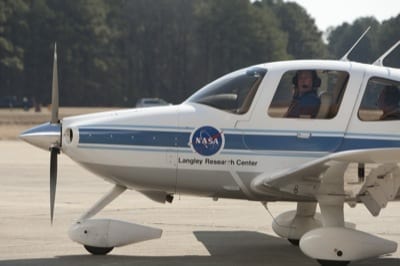Researchers at NASA’s Langley Research Center in Hampton Roads, Va., have a new twist on an old saying, “Look Ma, no hands,” when it comes to piloting a small plane.
The new twist is a result of a NASA partnership with The MITRE Corporation and the University of North Dakota (UND).
 “This a vital step in our ongoing sense-and-avoid technology research,” said Mark Askelson, a UND atmospheric scientist working on the unmanned aircraft systems research project. “This partnership with MITRE and NASA Langley are especially important as we move toward aircraft that will one day be equipped with ADS-B or Automatic Dependent Surveillance-Broadcast. The ADS-B system, together with more reliable and accurate sense-and-avoid technology, will be vital to future UAS operations.”
“This a vital step in our ongoing sense-and-avoid technology research,” said Mark Askelson, a UND atmospheric scientist working on the unmanned aircraft systems research project. “This partnership with MITRE and NASA Langley are especially important as we move toward aircraft that will one day be equipped with ADS-B or Automatic Dependent Surveillance-Broadcast. The ADS-B system, together with more reliable and accurate sense-and-avoid technology, will be vital to future UAS operations.”
The team is using a NASA Langley general aviation aircraft — a Cirrus SR-22 — that was developed as a testbed to assess and mimic unmanned aircraft systems. Capitalizing on NASA Langley’s years of flight test experience, the Cirrus SR-22 is equipped with special cockpit technology and computer equipment loaded with automatic “sense-and-avoid” software algorithms developed by MITRE and UND.
During a Sept. 20 flight demonstration at the Grand Forks International Airport in North Dakota, the NASA aircraft will show how technology onboard can allow it to sense and avoid a UND Cessna 172 “intruder” plane, being flown by university instructor pilots. The Cirrus will have a safety pilot in the cockpit, but researchers say three computer programs developed by MITRE and one by UND will automatically fly the plane.
 The flight demonstration is part of the Limited Deployment–Cooperative Airspace Project (LD-CAP). It is a multi-institution research project designed to help better integrate unmanned aircraft, equipped with technology, such as satellite-based Automatic Dependent Surveillance-Broadcast ADS-B data-link tracking, into the national air transportation system.
The flight demonstration is part of the Limited Deployment–Cooperative Airspace Project (LD-CAP). It is a multi-institution research project designed to help better integrate unmanned aircraft, equipped with technology, such as satellite-based Automatic Dependent Surveillance-Broadcast ADS-B data-link tracking, into the national air transportation system.
Remotely piloted, unmanned aircraft systems are growing in popularity and have many potential uses, including remote firefighting, search and rescue and surveillance. But their routine use in civil airspace creates technical, operational and policy challenges.
LD-CAP is trying to address one of the biggest challenges — development of a way for unmanned aircraft to sense and avoid other planes to compensate for not having a pilot on board capable of seeing and avoiding other aircraft.
Automatic sense-and-avoid software includes the ability to keep aircraft safely separated from one another and to take immediate action to avoid any imminent collisions when the ground-based, remote pilot does not react. These initial flight tests will validate work done in simulation and help engineers determine how they can design systems so that unmanned aircraft can be safely incorporated into the skies.
Follow-on testing in 2013 is expected to feature additional advanced software by MITRE and UND as well as sense-and-avoid software managed by “Timeliner,” a task automation framework developed by Draper Laboratory that is currently in use on the International Space Station.
